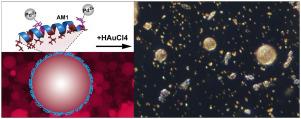Particuology ( IF 4.1 ) Pub Date : 2021-06-24 , DOI: 10.1016/j.partic.2021.06.003 Ching-Min Yeh , Thomas Jarrett , Yuan Gao , Chun-Xia Zhao , Andrew Whittaker , Frank Sainsbury , Alison L. White

|
Designer biosurfactants can be used to stabilise and functionalise interfaces. One particularly promising use is the stabilisation of oil-in-water emulsions, enabling fine tuning physical, chemical and biological surface properties. The ability of emulsion systems to carry high payloads makes them attractive for applications in medicine, food and fragrances, and cosmetics. However, they have limited long-term stability. Here we sought to use the metal ion-chelating ability of the biosurfactant peptide, AM1, to precipitate the formation of a gold metal shell on AM1-stabilised emulsions by electroless plating. We found that replacing the commonly used zinc(II) with palladium(II) for coordination by histidine residues of adjacent AM1 peptides produced interfacial films that maintained elasticity at acidic pH. Proton NMR suggested a coordination mechanism independent of the imidazole ring of the histidines. Nevertheless. stabilisation of emulsions at low pH enabled the deposition of a gold shell, albeit by an unexpected mechanism. We propose that gold nanoparticles forming in bulk are adsorbed onto the peptide-stabilised interface, accumulating into a particulate coating. The resulting one-step method for nanoparticle precipitation and shell formation will be useful for the creation of biocompatible core-shell particles for applications where large payloads of hydrophobic active compounds require stability over long time periods.
中文翻译:

使用金属离子螯合生物表面活性剂模板化核壳颗粒
设计师生物表面活性剂可用于稳定和功能化界面。一种特别有前景的用途是稳定水包油乳液,从而微调物理、化学和生物表面特性。乳液系统承载高有效载荷的能力使其在医药、食品和香水以及化妆品中的应用极具吸引力。然而,它们的长期稳定性有限。在这里,我们试图利用生物表面活性剂肽 AM1 的金属离子螯合能力,通过化学镀在 AM1 稳定的乳液上沉淀金金属壳的形成。我们发现用钯 (II) 代替常用的锌 (II) 以通过相邻 AM1 肽的组氨酸残基进行配位,产生了在酸性 pH 下保持弹性的界面膜。质子核磁共振表明配位机制独立于组氨酸的咪唑环。尽管如此。乳液在低 pH 值下的稳定化使金壳沉积成为可能,尽管这是一种意想不到的机制。我们建议大量形成的金纳米粒子被吸附到肽稳定的界面上,积累成颗粒涂层。由此产生的用于纳米颗粒沉淀和壳形成的一步法将有助于创建生物相容性核壳颗粒,用于需要长时间稳定性的大量疏水活性化合物的应用。我们建议大量形成的金纳米粒子被吸附到肽稳定的界面上,积累成颗粒涂层。由此产生的用于纳米颗粒沉淀和壳形成的一步法将有助于创建生物相容性核壳颗粒,用于需要长时间稳定性的大量疏水活性化合物的应用。我们建议大量形成的金纳米粒子被吸附到肽稳定的界面上,积累成颗粒涂层。由此产生的用于纳米颗粒沉淀和壳形成的一步法将有助于创建生物相容性核壳颗粒,用于需要长时间稳定性的大量疏水活性化合物的应用。











































 京公网安备 11010802027423号
京公网安备 11010802027423号